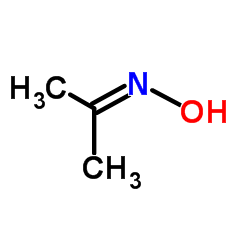Propan-2-one oxime

Propan-2-one oxime structure
|
Common Name | Propan-2-one oxime | ||
|---|---|---|---|---|
| CAS Number | 127-06-0 | Molecular Weight | 73.094 | |
| Density | 0.9±0.1 g/cm3 | Boiling Point | 135.0±0.0 °C at 760 mmHg | |
| Molecular Formula | C3H7NO | Melting Point | 60-63 °C(lit.) | |
| MSDS | Chinese USA | Flash Point | 45.2±8.0 °C | |
|
Slow oxidation of acetoxime and methylethyl ketoxime to the corresponding nitronates and hydroxy nitronates by liver microsomes from rats, mice, and humans.
Toxicol. Sci. 47(2) , 144-50, (1999) Acetoxime and methylethyl ketoxime (MEKO) are tumorigenic in rodents, inducing liver tumors in male animals. The mechanisms of tumorigenicity for these compounds are not well defined. Oxidation of the oximes to nitronates of secondary-nitroalkanes, which are ... |
|
|
Synthesis and anticancer evaluation of benzyloxyurea derivatives.
Chem. Pharm. Bull. 62(9) , 898-905, (2014) A series of novel benzyloxyurea derivatives was designed, synthesized by substituting different benzyls or phenyls on N,N'-positions of the hydroxyurea (HU). These target compounds were evaluated for their anticancer activity in vitro against human leukemia c... |
|
|
Reversion of structure-activity relationships of antitumor platinum complexes by acetoxime but not hydroxylamine ligands.
Mol. Pharmacol. 71(1) , 357-65, (2007) The presence of cis-configured exchangeable ligands has long been considered a prerequisite for antitumor activity of platinum complexes, but over the past few years, several examples violating this structure-activity relationship have been recognized. We rep... |
|
|
Amination of tyrosine in liver cytosol protein of male F344 rats treated with 2-nitropropane, 2-nitrobutane, 3-nitropentane, or acetoxime.
Chem. Res. Toxicol. 10(12) , 1420-6, (1997) Previously, the secondary nitroalkane 2-nitropropane, a strong hepatocarcinogen in rats, had been shown to induce the formation of 8-aminoguanine in both DNA and RNA of rat liver through a sulfotransferase-mediated pathway. This pathway was postulated to conv... |
|
|
Sex and organ differences in oxidative DNA and RNA damage due to treatment of Sprague-Dawley rats with acetoxime or 2-nitropropane.
Carcinogenesis 11(9) , 1659-62, (1990) The hepatocarcinogens 2-nitropropane and acetoxime have previously been found to induce a specific and qualitatively identical pattern of base damage in rat liver DNA and RNA, including the induction of increased levels of 8-hydroxyguanine. Because both 2-nit... |
|
|
Oxidative DNA and RNA damage in rat liver due to acetoxime: similarity to effects of 2-nitropropane.
Carcinogenesis 11(6) , 1013-6, (1990) Acetoxime (ACO) and 2-nitropropane (2-NP), both industrially important chemicals and known hepatocarcinogens in rats, induced increased levels of 8-hydroxy-guanine in liver DNA and RNA of male Sprague-Dawley and F344 rats after either oral or i.p. administrat... |
|
|
Carcinogenicity test of acetoxime in MRC-Wistar rats.
J. Natl. Cancer Inst. 69(4) , 961-2, (1982) Acetoxime was tested for carcinogenicity by chronic administration in the drinking water to male and female outbred MRC-Wistar rats. The dose of 1.0 g/liter was administered 5 days/week for 18 months (total dose, 6.2--7.0 g/rat). The test compound induced ben... |
|
|
Ab initio molecular electrostatic potentials of perillartine analogues: implications for sweet-taste receptor recognition.
J. Med. Chem. 31(10) , 1879-85, (1988) A model for the recognition of the perillartine analogues has been determined from a consideration of the molecular electrostatic potentials calculated at the ab initio 3-21G level for a select set of biologically active analogues. The model stresses the impo... |
|
|
Acetoxime is metabolized by human and rodent hepatic cytochrome P450 enzymes to the genotoxicant and carcinogen propane 2-nitronate.
Carcinogenesis 13(7) , 1091-4, (1992) The hepatocarcinogenicity of acetoxime has been tentatively linked with its metabolic oxidation to the potent genotoxicant and carcinogen propane 2-nitronate (P2-N). In order to test the hypothesis that acetoxime is metabolized to P2-N, the oxime (20 mM) was ... |
|
|
Human phenol sulfotransferases hP-PST and hM-PST activate propane 2-nitronate to a genotoxicant.
Carcinogenesis 21(2) , 295-9, (2000) The industrial solvent 2-nitropropane (2-NP) is a genotoxic hepatocarcinogen in rats. The genotoxicity of the compound in rats has been attributed to sulfotransferase-mediated formation of DNA-reactive nitrenium ions from the anionic form of 2-NP, propane 2-n... |